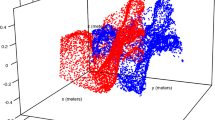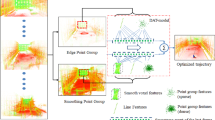Abstract
We utilize a more accurate range noise model for 3D sensors to derive from scratch the expressions for the optimum plane fitting a set of noisy points and for the combined covariance matrix of the plane’s parameters, viz. its normal and its distance to the origin. The range error model used by us is a quadratic function of the true range and also the incidence angle. Closed-form expressions for the Cramér–Rao uncertainty bound are derived and utilized for analyzing four methods of covariance computation: exact maximum likelihood, renormalization, approximate least-squares, and eigenvector perturbation. The effect of the simplifying assumptions inherent in these methods are compared with respect to accuracy, speed, and ease of interpretation of terms. The approximate least-squares covariance matrix is shown to possess a number of desirable properties, e.g., the optimal solution forms its null-space and its components are functions of easily understood terms like the planar-patch’s weighted centroid and scatter. It is also fast to compute and accurate enough in practice. Its experimental application to real-time range-image registration and plane fusion is shown by using a commercially available 3D range sensor.
Similar content being viewed by others
References
Anderson D, Herman H, Kelly A (2005) Experimental characterization of commercial flash ladar devices. In: International conference on sensing technologies. Palmerston North, New Zealand. http://www.frc.ri.cmu.edu/~alonzo/pubs/papers/icst05FlashLadar.pdf
CSEM (2006) The SwissRanger, Manual V1.02. 8048 Zurich, Switzerland. http://www.swissranger.ch
Horn RA, Johnson CR (1985) Matrix analysis. Cambridge University Press, Cambridge
Kanatani K (2005) Statistical optimization for geometric computation. Dover Publications, Inc., New York. ISBN 0486443086
Kanazawa Y, Kanatani K (1995) Reliability of fitting a plane to range data. IEICE Trans Inform Syst E78-D(12): 1630–1635
Kohlhepp P, Pozzo P, Walther M, Dillmann R (2004) Sequential 3D-SLAM for mobile action planning. Intelligent Robots and Systems, 2004. (IROS 2004). Proceedings of the 2004 IEEE/RSJ International Conference, vol 1, pp 722–729 doi:10.1109/IROS.2004.1389438
Nüchter A, Lingemann K, Hertzberg J (2007) 6D SLAM—3D mapping outdoor environments. J Field Robot 24(8/9): 699–722
Pathak K, Birk A, Schwertfeger S, Poppinga J (2007) 3d forward sensor modeling and application to occupancy grid based sensor fusion. In: International conference on intelligent robots and systems (IROS). IEEE Press, San Diego, USA
Pathak K., Birk A., Vaskevicius N., Pfingsthorn M., Schwertfeger S., Poppinga J (2010) Online Three-Dimensional SLAM by registration of large planar surface segments and closed-form pose-graph relaxation. J Field Robot (to appear). doi:10.1002/rob.20322
Pathak K, Vaskevicius N, Birk A (2009) Revisiting uncertainty analysis for optimum planes extracted from 3D range sensor point-clouds. In: International conference on robotics and automation (ICRA), pp 1631–1636. IEEE Press, Kobe, Japan. doi:0.1109/ROBOT.2009.5152502
Pathak K, Vaskevicius N, Poppinga J, Pfingsthorn M, Schwertfeger S, Birk A (2009) Fast 3d mapping by matching planes extracted from range sensor point-clouds. In: International conference on intelligent robots and systems (IROS). IEEE Press
PMD Technologies (2008) PhotonIC (R) PMD 3k-S. http://www.pmdtec.com
Poppinga J, Vaskevicius N, Birk A, Pathak K (2008) Fast plane detection and polygonalization in noisy 3D range images. In: IEEE international conference on intelligent robots and systems (IROS). Nice, France
Prieto F, Redarce T, Boulanger P, Lepage R (1999) CAD-based range sensor placement for optimum 3D data acquisition. In: Second international conference on 3-D imaging and modeling (3DIM’99), p 0128. IEEE Computer Society, Los Alamitos, CA, USA. http://doi.ieeecomputersociety.org/10.1109/IM.1999.805343
Sivia DS (1996) Data analysis: a Bayesian tutorial. Oxford University Press, Oxford. ISBN 0198518897
Surmann H, Nuechter A, Hertzberg J (2003) An autonomous mobile robot with a 3d laser range finder for 3d exploration and digitalization of indoor environments. Robot Auton Syst 45(3–4): 181–198
Wang C, Tanahashi H, Hirayu H, Niwa Y, Yamamoto K (2001) Comparison of local plane fitting methods for range data, vol. 1, pp I-663–I-669. doi:10.1109/CVPR.2001.990538
Weingarten J (2006) Feature-based 3D SLAM. Ph.D. thesis, EPFL, Lausanne, Switzerland. http://library.epfl.ch/theses/?nr=3601
Weingarten J, Siegwart R (2006) 3D SLAM using planar segments. In: IEEE/RSJ international conference on intelligent robots and systems (IROS), Beijing
Weng J, Huang TS, Ahuja N (1989) Motion and structure from two perspective views: algorithms, error analysis, and error estimation. IEEE Trans Pattern Anal Mach Intell 11(5): 451–476. doi:10.1109/34.24779
Author information
Authors and Affiliations
Corresponding author
Rights and permissions
About this article
Cite this article
Pathak, K., Vaskevicius, N. & Birk, A. Uncertainty analysis for optimum plane extraction from noisy 3D range-sensor point-clouds. Intel Serv Robotics 3, 37–48 (2010). https://doi.org/10.1007/s11370-009-0057-4
Received:
Accepted:
Published:
Issue Date:
DOI: https://doi.org/10.1007/s11370-009-0057-4




